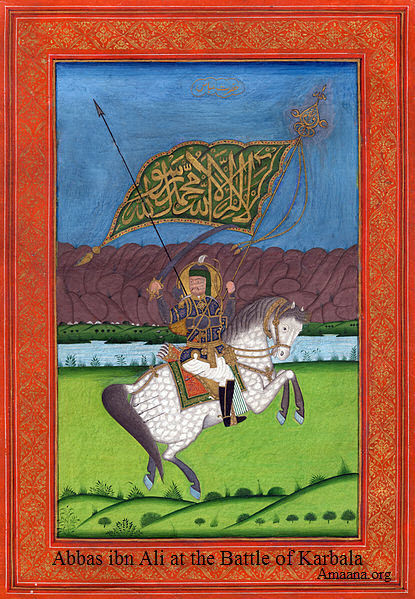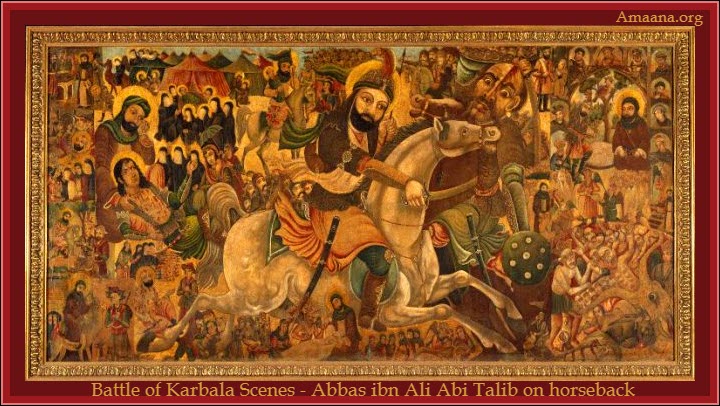
“We are the House of Muhammad and as such are more entitled to the authority (walāyah) of this affair over you than these pretenders who claim what does not belong to them… By God there is no son of a Prophet other than me among you and among the peoples from East to West.”
— Imām al-Ḥusayn ibn ‘Alī
The tenth day of Muḥarram, known as the Day of ‘Āshūra’ is when the Battle of Karbala took place – in which Imām al-Ḥusayn ibn ‘Alī, the second hereditary Imām of the Shī‘ī Muslims, along with his family and supporters, was brutally massacred by the armies of Yazīd ibn Mu‘āwiya ibn Abī Sufyān.
“When I ask you to read Kisso (the account of the events at Karbala) it is not because those who read it will go to Paradise, but that you may ponder over it and know the unbelievers fought us. These Prophets and Imāms knew what was going to happen, yet we are not allowed to reveal the mysteries of the Unseen (ghayb).”
— Imām Āgā Shāh ‘Alī Shāh Āgā Khān II, (transl. Rai Gulamali Kassam Shivji, Calgary November 1989)
The Battle of Karbala, from the esoteric perspective, was the manifestation of the opposition that takes place in every age and time between the forces of the Imām of the Time and the forces of his Adversity (ḍidd). Just as the Imām of the Time is the inheritor of Haḍrat Adam and the vicegerent of God on earth, the Adversary (ḍidd) is the inheritor of Iblīs and the devil (shayṭān) among human beings.
“Likewise did We appoint for every Messenger an enemy: devils (shayāṭīna) among mankind and jinns, inspiring each other with flowery discourses by way of deception. If thy Lord had so planned, they would not have done it: so leave them and their inventions alone.”
— (Holy Quran 6:112)
“Likewise, century after century, and epoch after epoch, every time has its Iblīs, may God’s curses be upon him, and its Adam, may God’s prayers be upon him.”
— al-Mu’ayyad al-Shirāzī, (Majālis al-Mu’ayyadiyyah, Vol. II, Majlis No. 11, 71)
The Ismā‘īlī Imāms have also referred to this Adversary or Iblis of the Time as the “pharaoh” who tries to lead people astray in the age of every Imām.
“There is a physical and spiritual pharaoh in the cycle of every Imām. By means of the power and influence of his defiled soul he leads astray the simple-minded servants who are not yet firm-footed on the way of the bearer of truth, diverting them from the path of the most sublime paradise and supreme heaven to the nethermost hell, which is the land of the hypocrites (munafiqan).”
— Imām Islāmshāh, (Seven Aphorisms, quoted in The Ismailis in the Middle Ages, 107)
Just as the Imām is the bearer of the light of walāyah which bring human beings closer to God, the Adversary manifests the darknesses of the “counter-walāyah” which leads people astray. As al-Mu’ayyad al-Shirāzī explains, the Imām and his hierarchy (ḥudūd) of spiritual teachers are the embodiment of virtues known as the Adamic Forms (al-ṣuwar al-ādamiyyah) and they are opposed by the Adversary and his counter-hierarchy of deceptors who embody the decadent vices known as Satanic Shapes (al-ashkāl al-shayṭāniyyah). In other words, there exist the Imāms of Truth (a’immat al-ḥaqq) as well as the imāms of going astray (a’immat al-ḍalāl).
(…)
The Imām and the Adversary (ḍidd)

The difference between the true Imām and the Adversary – the false imām – is that the true Imām is inspired by the Holy Spirit (al-mu’ayyad bi’l-rūḥ al-quds) while the false imām attempts to imitate the true Imām and usurp his rights. This opposition even existed in the eras of the Imāms who preceded the Prophet Muḥammad and Imām ‘Alī ibn Abī Ṭālib. For example, Mawlānā Hāshim ibn ‘Abd Manāf (the great grandfather of the Prophet) was the Imām of his time and his Adversary was his own his half-brother Umayyah – whom he banished from Mecca. There was similar opposition between Mawlānā ‘Abd al-Muṭālib (the grandfather of the Prophet) and the Adversary of his age who was Ḥarb ibn Umayyah – particularly over the custodianship of the Ka‘ba. At the time of the Prophet Muḥammad, the Adversary or the imām of falsehood was none other than Abū Sufyān ibn Harb – who led the Quraysh in opposing the Prophet. In the time of Imām ‘Alī ibn Abī Ṭālib, the Adversary was Mu‘āwiya ibn Abī Sufyān. And so, in the time of Imām al-Ḥusayn ibn ‘Alī, the Adversary was Yazīd ibn Mu‘āwiya ibn Abī Sufyān. The opposition between the true Imām, who has the rank of Adam, and his Adversary (ḍidd), who embodies Iblīs, exists in every age and cycle:
(…)
Imām al-Ḥusayn at Karbala

In the field at Karbala, a fierce battle was waged against Imām al-Ḥusayn. At that time he fought alone against thousands of men. He endured the immense suffering and cruelty by the hands of his enemies and in spite of all this he still proclaimed: “I am the Imām.”
— Imām Sulṭān Muḥammad Shāh Āgā Khān III, (Address made in Kutch Nagalpur, November 28, 1903)
Read full on Amaana org
->>>>><<<<<-



















